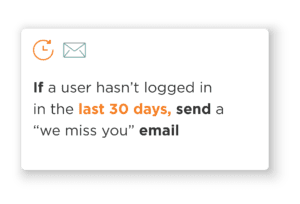
6 Steps for Sustaining Community Engagement Year-Round
As a community professional, you might be wondering how you can sustain high engagement after a spike (caused by something like, say, COVID-19). How can you support long-term engagement? We’ll look at processes you can set up to do that.
Many of our customers have seen an increase in community engagement during COVID-19. In fact, we saw a 33%+ increase in usage and new members across our platforms. It makes sense because their community members were confronted with a series of challenges they’ve never encountered before. They reached out to their networks to seek support and learn how their peers were solving these challenges.
Want to dig deeper? Check out our complete guide to online community.
As a community professional, you might be wondering how you can sustain these levels of engagement after a spike. How can you organize your team to support long-term engagement? We’ll look at processes you can set up to do just that.
Step 1: Pause for a strategic review and reset
It’s easy to get caught up in the fast-moving pace of everyday communications. Especially in professional contexts, many of us are in “go go go” mode. There’s very little time to pause and reflect away from digital distractions. Especially when you’re managing an online community, you’re continuously following and participating in discussions.
But you need to look up and ahead into the future. Strategic decisions require long-term thinking. When you’re focused on “right now,” you can’t start planning what’s next.
That’s why your team needs to pause, reflect, and take space. Take time for a strategic reset. Stop executing for a set period of time, and arrange time to meet, distraction-free. Focus on debriefing and sharing your thoughts. What engagement tactics are working? What could be improved? What seems surprising?
After you debrief as a team, use that opportunity to re-open the conversation with other teams at your organization. What are the biggest challenges they’re facing? How can the community help them achieve their goals?
If you weren’t able to loop in some teams into the community plans when you first launched, it’s a good time to check in with them and integrate the community more deeply into your organization’s initiatives.
This alignment will help ensure that your internal stakeholder team is rowing together, in the right direction, as everyone moves forward. With a shared understanding of successes and challenges, you’ll be well-equipped to progress to the next phase of your strategy.
Step 2: Prioritize efforts to improve your focus
High-performing teams are machines for incredible ideas. Most likely, during your team debrief, everyone will have recommendations for tactics to implement. But keep in mind that you only have limited time and resources. You need to prioritize your time accordingly.
One way to navigate this challenge is to build a community roadmap. See what you’d like to pursue and prioritize it based on the needs and time of your team. With this approach, you’ll ensure that all ideas are represented — and that suggestions don’t fall through the cracks.
What’s most essential right now? What’s a nice-to-have? What can wait?
This sense of focus will help your team make more impactful decisions.
Step 3: Automate your processes
A challenge that many community managers encounter over time is the ability to scale. It can be difficult to develop a robust community without adding additional staff members. But one way to solve that problem to lean into any automations built into your online community platform.

Set up your automation infrastructure as early as possible. Automating things like your new member welcome emails can give you time back in your day to refine other processes or work develop new strategies. Like with any automated process, set up a recurring time to monitor the effectiveness, test, and refine to make sure it remains impactful. If the conversion rates are where you want them, you can prioritize other initiatives to enhance the community experience.
Automation will equip you with the scaffolding to create better content. And doing little things like sending emails from your real email address and making sure you’re responding promptly with your authentic voice and tone will help you nurture relationships without ever sounding like a robot.
Learn more about how you can use automation rules in your online community.
Step 4: Create a community super user program
Online communities take time and energy to maintain, as you know. A great tactic for alleviating some of the burden is to create a community super user or champions program. Find your MVPs (use automation rules to identify your most involved community members) and create an official program with responsibilities. It might make sense right now to have a lot of super users so that you can give them each a small chunk of the responsibility. Create a shared plan for maintaining discussions, sharing fresh content, and keeping discussions going.
If you already have a super user program but you’re seeing a lack of participation, take some time to check in with your MVPs. Are they doing okay on a personal level? How are they holding up? If you find that the program is too big of a burden at the moment, give them a small way to stay involved and transition their responsibilities over to community members who may have more time.
Step 5: Give people reasons to keep coming back
If you’re noticing that people have stopped engaging with a particular mode of communication (i.e. email newsletter), try a different engagement tactic — like sharing a poll, for instance.
If you’re not sure what tactics work best to engage your community members, try running several different programs, measuring their value, and seeing what works best. You might consider doing:
- Ask Me Anything sessions with experts
- Interactive casual events over Zoom, sometimes called office hours or virtual roundtables
Find little ways to encourage momentum and drive traffic to your community. These little pushes add up to help online community engagement, especially when you’re continuously sharing interesting content.
One way to promote the online community and its value is to feature community content in your emails and newsletters, especially any emails that go out to non-members or customers. This is a great opportunity to work across teams and collaborate with your marketing or communications teams and show how the community can help you acquire new members or customers.
Step 6: Interview community members
When it comes to brainstorming and expanding your horizons as a community leader, real-life conversations are priceless. Even a 15 to 20-minute phone interview can make a difference.
These types of conversations will help you build stronger connections with your community members. After all, that person is more than an avatar or series of comments on a computer screen. So are you.
When I was a community manager, I tried to always have at least one Zoom conversation with one of my community members once a week. I kept the conversations to just 15 minutes.
If you’re not seeing high engagement in your online community, this is a great thing to ask your community member about. Are you sharing the right content or does it not apply to them? What would be more useful? Are they feeling burned out digitally? Have a transparent conversation about what they need and how you could do more in the community to help them.
Even though it’s short, this approach really does jumpstart engagement. That community member knows you’re a real person behind the screen, and in the future, when they get an email with your name on it, they know that you’re listening and that you care.
Final Tips to Sustain Quality Engagement
Community building takes creativity, dedication, and hard work, but you have lots of strategies you can use to prioritize and use time effectively. Keep these closing tips in mind:
- Keep doing what’s working. As you reflect with your team, make sure the most effective best practices and tactics keep getting applied in your community.
- It’s never too late to leverage effective launch tactics. Whether you’re adding a welcome email or an “introduce yourself” discussion thread, these launch-level tactics can continue to invite engagement.
- Automation doesn’t mean that you need to sacrifice personal connections. As a community manager, you’ll need to build processes to help you scale to avoid burnout. You need to lean into that technology to make your job easier, better, and faster.
- Don’t be afraid to tinker. Your community is more important than ever, and with refinement and testing you can deliver engaging, helpful content. But as you test, don’t change too much at one time.
- Finally, build and document those operational processes that your organization can use for years to come.
Want more examples of how other organizations are making these strategies work? Listen to the webinar.



